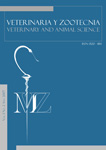Autores/as
Resumen
RESUMEN: Existen pocos datos en la literatura relacionados con los rangos de referencia de acilcarnitinas en manchas de sangre seca en papel de filtro para perros y si estos rangos de referencia dependen del género. Este artículo describe el establecimiento de dichos rangos de referencia para caninos adultos. Se tomaron muestras de sangre de 60 perros adultos normales (30 machos y 30 hembras), ayunados y que no presentaban ninguna evidencia de desordenes del metabolismo del acil-CoA. Fueron preparadas manchas de sangre seca para el análisis de acilcarnitinas utilizando espectrometría de masa en tándem. No se encontraron diferencias significativas realcionadas con el sexo, se obtuvo un perfil normal de acilcarnitinas en los caninos. Es importante resaltar la ausencia de hidroxiacilcarnitinas y glutarilcarnitina cuando se procesan muestras normales.
Palabras clave
Citas
Bartlett, K.; Eaton S.J.; Pourfarzam, M. New developments in neonatal screening. Archives of Disease in Childhood, v.77, p.151-154, 1997.
Bartlett, K.; Pourfarzam, M. Tandem mass spectrometry- The potential. Journal of Inherited Metabolic Disease, v.22, p.568-571, 1999.
Faunt K.K.; O`Brien D.P. Malonic aciduria in Maltese dogs. Journal of Veterinary Internal Medicine, v.12, p.236, 1998.
Green, A. ; Pollit, R.J. Population newborn screening for inherited metabolic disease: Current UK perspectives. Journal of Inherited Metabolic Disease, v.22, p.572- 579, 1999.
Greter, J. ; Jacobson, C.E. Urinary organic acids: isolation and quantification for routine metabolic screening. Clinical Chemistry, v.33, p.473-480, 1987.
Heathers, G.P.; Yamada, K.A.; Kanter, E.M.; Corr, P.B. Long-chain acylcarnitines mediate the hypoxia- induced increase in alpha 1-adrenergic receptors on adult canine myocytes. Circulation Research, v.61, n.5, p.735-46, 1987.
Johnson J.W.; Lee, M.S.; Lee, M.R.; Yost, T. Triple Quadrupole MS/MS in Biomedical Research. Mass Spectrometry in Biomedical Research. London, 1986:459-457.
Levy, H.L. Newborn screening by tandem mass spectrometry: a new era. Clinical Chemistry, v.44, p.2401-2402, 1998.
Libert R.; Van Hoof, F.; Thillaye, M. et al. Identification of new medium-chain acylcarnitines present in urine of a patient with medium-chain acyl-CoA dehydrogenase deficiency. Journal of Inherited Metabolic Disease, v.22, p.9-18, 1999.
McHowat, J.; Yamada, K.A.; Saffitz, J.E. et al. Subcellular distribution of endogenous long chain acylcarnitines during hypoxia in adult canine myocytes. Cardiovascular Research, v.27, n.7, p.1237-1243, 1993.
Millington, D.S.; Kodo, N.; Norwood, D.L. et al. Tandem Mass Spectrometry: A new method for acylcarnitine profiling with potential for neonatal screening for inborn errors of metabolism. Journal of Inherited Metabolic Disease, v.13, p.321-324, 1990.
Millington, D.S ; Kodo, N.; Terada, N. et al. The analysis of diagnostic markers of genetic disorders in human blood and urine using tandem mass spectrometry with liquid secondary ion mass spectrometry. International Journal of Mass Spectrometry, v.111, p.211-228, 1991.
Millington, D.S.; Chace, D.H. Carnitine and acylcarnitines in metabolic disease diagnosis and management. Mass spectrometry: clinical and biomedical applications, Plenum Press, New York, 1992: 299-316.
Millington, D.S.; Chace, D.H.; Hillman, S.L. Diagnosis of Metabolic Disease. Biological Mass Spectrometry: Present and Future, London, 1994:559-579.
Moser, H.W.; Moser, A.B. Measurement of saturated very long chain fatty acids in plasma. Techniques in diagnostic Human Biochemical Genetics: a laboratory manual. Wiley-Liss, New York, 1991:177- 192.
O’Brien, D.P.; Barshop, B.A.; Faunt, K.K. et al. Malonic aciduria in Maltese dogs: normal methylmalonic acid concentrations and malonyl-CoA decarboxylase activity in fibroblasts. Journal of Inherited Metabolic Disease, v.22, n.883-90, 1999.
Osorio, J.H.; Bassols A. Determinación de carnitina libre y total en perros. Medicina Veterinaria, v.19, n.11, p.136-140, 2002.
Podell, M.; Shelton, G.D.; Nyhan, W.L. Methylmalonic and malonic aciduria in a dog with progressive encephalomyelopathy. Metabolic Brain Disease, v.11, n.3, p.239-247, 1996.
Pourfarzam, M.; Schaefer, J.; Turnbull, D.M. et al. Analysis of fatty acid oxidation intermediates in cultured fibroblasts to detect Mitochondrial oxidation disorders. Clinical Chemistry, v.40, p.2267-2275, 1994.
Rashed, M.S.; Ozand, P.T.; Bennet, M.J. Inborn errors of metabolism diagnosed in sudden death cases by acylcarnitine analysis of postmorten bile. Clinical Chemistry, v.4, p.1109-1114, 1995.
Schaefer, J.; Pourfarzam, M.; Bartlett, K. et al. Fatty acid oxidation in peripheral blood cells: characterisation and use for the diagnosis of fatty acid oxidation. Pediatric Research, v.37, p.345-360, 1995.
Shigmatsu, Y.; Hata, I.; Nakai, A. et al.-Prenatal Diagnosis of Organic Acidemias Based on Amniotic Fluid Levels of Acylcarnitines. Pediatric Research, v.39, p.680- 684, 1996.
Vianey-Saban, N.; Guffon, F.; Delolne, P. et al. Diagnosis of inborn errors of metabolism by acylcarnitine profiling in blood using tandem mass spectrometry. Journal of Inherited Metabolic Disease, v.20, p.411-444, 1997.
Vogel, W.M.; Bush, L.R.; Cavallo, G.C. et al. Inhibition of long-chain acylcarnitine accumulation during coronary artery occlusion does not alter infarct size in dogs. Journal of Cardiovascular Pharmacology, v.23, n.5, p.826-832, 1994.
Vreken, P.; Van Lint, A.E.M.; Bootsma, A.H. et al. Quantitative plasma acylcarnitine analysis using electrospray tandem mass spectrometry for the diagnosis of organic acidaemias and fatty acid oxidation defects. Journal of Inherited Metabolic Disease, v.22, p.302-306, 1999.
Yamada, K.A.; Dobmeyer, D.J.; Kanter, E.M. et al. Delineation of the influence of propionylcarnitine on the accumulation of long-chain acylcarnitines and electrophysiologic derangements evoked by hypoxia in canine myocardium. Cardiovascular Drugs Theraphy, v.5, p.67-76, 1991 (Suppl 1).
Ziadeh, R.; Hoffman, E.P.; Finegold, N.D. Medium Chain Acyl-CoA dehydrogenase deficiency in Pennsylvania: neonatal screening shows high incidence and unexpected mutation frequencies. Pediatric Research, v.37, p.675-678, 1995.

 PDF
PDF
 FLIP
FLIP










